The Arctic
The sources of methane feedback emissions are:
o warming wetlands,
o thawing permafrost and
o over very long term warmed sea floor methane hydrates.
These regions hold three to four times all the carbon in the atmosphere.
The loss of all the summer sea ice will increase the rate of Arctic warming 3.5 times (D Lawrence 2008) which will boost the rate of methane emissions from the Arctic.
Since the record sea ice loss of 2007, the atmospheric methane concentration has been increasing and the scientists say this increase is due to wetland carbon feedback emissions, some of which is coming from the rapidly warming subarctic regions Arctic.
Wetlands are fast responders to an increase in regional warming.
Arctic methane hydrate has the potential to abruptly release a catastrophic amount of methane to the atmosphere, though considered unlikely.
Land based permafrost responds slower to warming as the methane is emitted as a result of micro-organisms digesting the thawed organic material.
However at a certain amount of thawing permafrost thaw becomes self perpetuating - irreversible. This because the microbial activity generates heat inside the thawing permafrost. Todays emissions of methane, CO and nitrous oxide from thawing permafrost is irreversible.
o warming wetlands,
o thawing permafrost and
o over very long term warmed sea floor methane hydrates.
These regions hold three to four times all the carbon in the atmosphere.
The loss of all the summer sea ice will increase the rate of Arctic warming 3.5 times (D Lawrence 2008) which will boost the rate of methane emissions from the Arctic.
Since the record sea ice loss of 2007, the atmospheric methane concentration has been increasing and the scientists say this increase is due to wetland carbon feedback emissions, some of which is coming from the rapidly warming subarctic regions Arctic.
Wetlands are fast responders to an increase in regional warming.
Arctic methane hydrate has the potential to abruptly release a catastrophic amount of methane to the atmosphere, though considered unlikely.
Land based permafrost responds slower to warming as the methane is emitted as a result of micro-organisms digesting the thawed organic material.
However at a certain amount of thawing permafrost thaw becomes self perpetuating - irreversible. This because the microbial activity generates heat inside the thawing permafrost. Todays emissions of methane, CO and nitrous oxide from thawing permafrost is irreversible.
Loss of Arctic summer sea ice effect on Northern hemisphere PDF.
The vast expanse of Arctic summer sea ice (and spring-summer snow) have a cooling effect on the region which moderates the climate and weather of the temperate northern hemisphere.
This the Arctic summer air conditioner for the entire Northern hemisphere (as described by scientists). The loss of the 'albedo' cooling effect will disrupt the climate and increase extreme weather in northern latitudes. Research shows this has started already and linked to polar jet stream disturbance.
Drought is projected to increase. Extreme cold could affect some regions at unseasonal times. Without an emergency response now, it can be expected that crop yields of the world's best food producing regions will progressively decline as Arctic temperatures increase faster.
The vast expanse of Arctic summer sea ice (and spring-summer snow) have a cooling effect on the region which moderates the climate and weather of the temperate northern hemisphere.
This the Arctic summer air conditioner for the entire Northern hemisphere (as described by scientists). The loss of the 'albedo' cooling effect will disrupt the climate and increase extreme weather in northern latitudes. Research shows this has started already and linked to polar jet stream disturbance.
Drought is projected to increase. Extreme cold could affect some regions at unseasonal times. Without an emergency response now, it can be expected that crop yields of the world's best food producing regions will progressively decline as Arctic temperatures increase faster.

Less Arctic albedo cooling results in more Arctic warming, an amplifying feedback called Arctic/polar amplification.
While the Arctic sea ice provides a vast extent of albedo cooling (which is now declining fast) to its September minimum, Far North snow from Spring to mid Summer provides an equally vast expanse of albedo cooling equivalent to the sea ice albedo (M. Flanner 2011). This is also rapidly declining as the snow declines earlier every year.
Arctic & Far North carbon
Arctic permafrost holds twice the carbon in the atmosphere and subsea floor frozen solid methane gas hydrate holds at least as much carbon as in the atmosphere. All this carbon will be released with too much warming, and that has started already.
While the Arctic sea ice provides a vast extent of albedo cooling (which is now declining fast) to its September minimum, Far North snow from Spring to mid Summer provides an equally vast expanse of albedo cooling equivalent to the sea ice albedo (M. Flanner 2011). This is also rapidly declining as the snow declines earlier every year.
Arctic & Far North carbon
Arctic permafrost holds twice the carbon in the atmosphere and subsea floor frozen solid methane gas hydrate holds at least as much carbon as in the atmosphere. All this carbon will be released with too much warming, and that has started already.
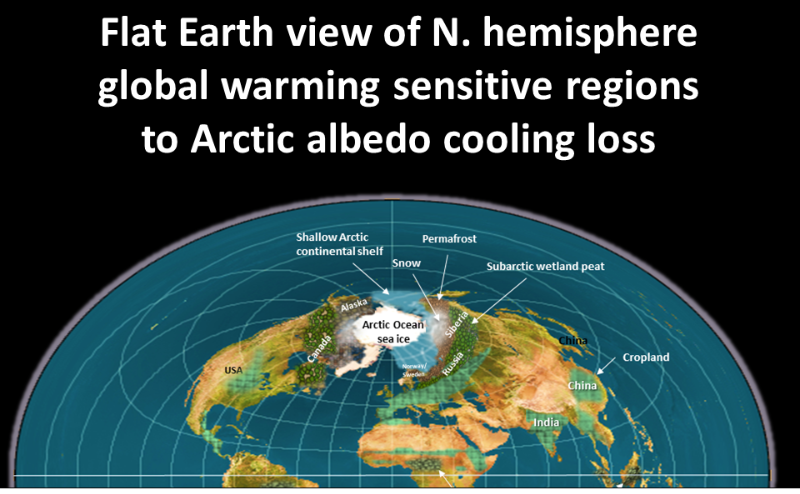
to 2014
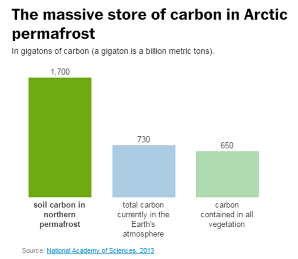
The Arctic is warming up to 4X the global average
Arctic permafrost carbon 350 PgC by 2100: +1.5C by 2100 (IPCC AR5 WG1 FAQ 6.1)
Arctic permafrost carbon 350 PgC by 2100: +1.5C by 2100 (IPCC AR5 WG1 FAQ 6.1)
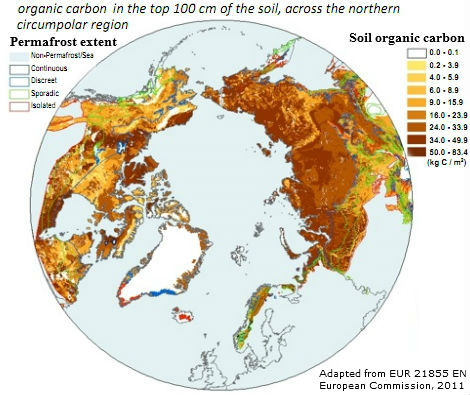
Earth Emergency The Arctic has switched from carbon sink to source with accelerating permafrost feedback underway NOAA Arctic Report Card 2016
July 2019 Total Arctic sea ice loss would be equivalent to 1 trillion tons CO2 emissions/25 years global warming
Site maintained by Peter Carter

Climate Emergency Institute
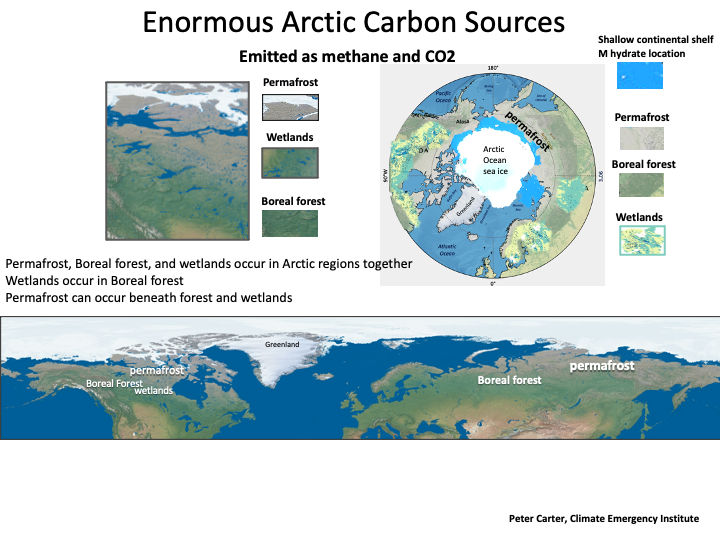
The Arctic at the top of the world is at the center of the planetary emergency and the trigger is the rapid loss of Spring-Summer Far North-Arctic snow and Summer sea ice.
Arctic snow& sea ice albedo cooling
This albedo cooling effect keeps the Arctic frozen and keeps the enormous pool of Far North and Arctic carbon safely cold and frozen. The shiny white snow and sea ice reflect incoming solar energy back out to space.
Permafrost
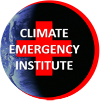
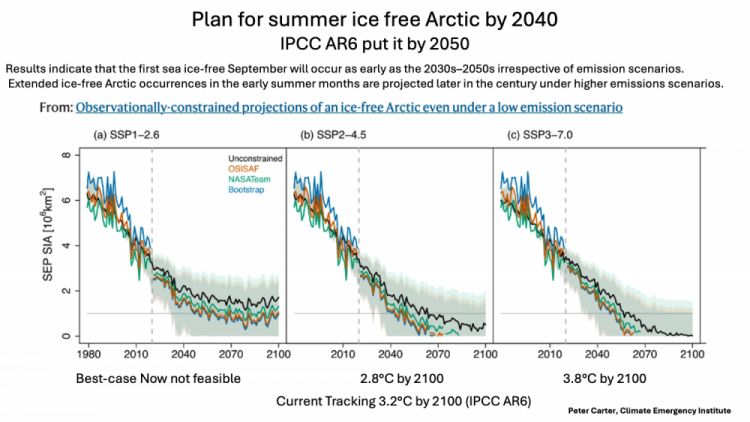
Vast Northern (subarctic) peat-rich wetlands are already emitting more methane.
Permafrost has been thawing for years and is emitting methane, much more CO2 than expected, and nitrous oxide- which is all irreversible.
Arctic continental shelf methane hydrate (frozen sold methane) under Arctic sea warming will emit methane slowly for 1000s of years. An explosive release is considered unlikely.
Permafrost has been thawing for years and is emitting methane, much more CO2 than expected, and nitrous oxide- which is all irreversible.
Arctic continental shelf methane hydrate (frozen sold methane) under Arctic sea warming will emit methane slowly for 1000s of years. An explosive release is considered unlikely.

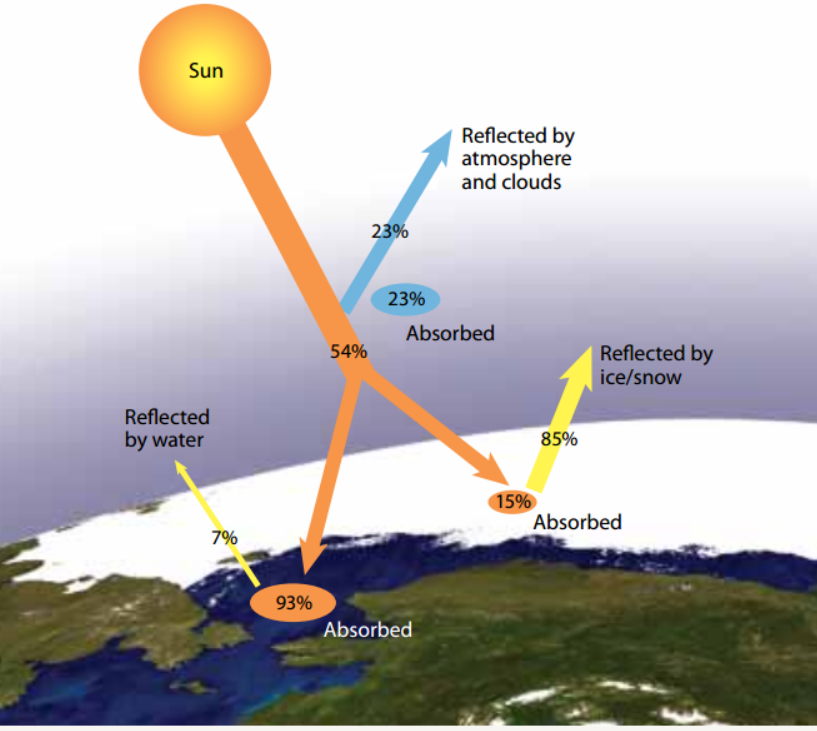
Arctic sea ice albedo (decline)
amplifyingfeedback
amplifyingfeedback
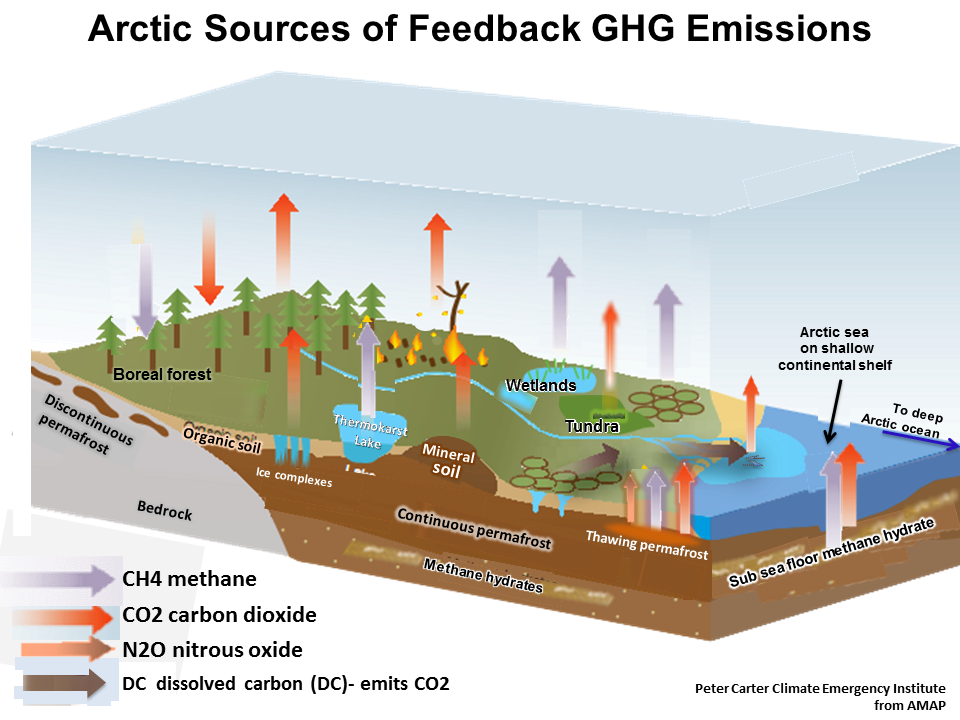
The single worst effect of global warming-
is triggering enormous sources of Arctic amplifying feedbacks and tipping points. This is now a certainty. It demands immediate action to put global emissions into decline by 2025 at the latest
(IPCC AR6, WG3, SPM ,C.1)
is triggering enormous sources of Arctic amplifying feedbacks and tipping points. This is now a certainty. It demands immediate action to put global emissions into decline by 2025 at the latest
(IPCC AR6, WG3, SPM ,C.1)
Double click here to edit this text.
NSIDC Daily Arctic sea ice extent